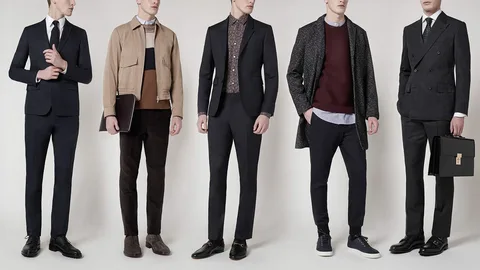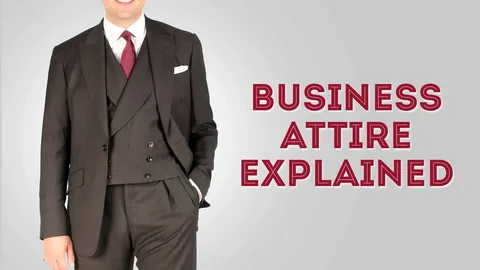When was the last time you felt stylish in the office? Some men spend over forty hours a week wearing a suit that conceals who they are: a boxy business suit, inexpensive shoes, and a novelty polyester tie-and-shirt combo purchased on sale three years ago.
Regarding dress regulations, we understand that some people must wear traditional business suits daily. However, office clothing can be attractive, requiring essential planning and effort to smooth out the sartorial creases.
Here are five office alternatives to the boring business suit, whether you’re a data-crunching finance professional or a creative agency employee.
Business Attire Guide for Men
Business professional attire.
For professional occasions such as interviews and career fairs, males should wear a well-tailored black, navy, or grey suit. They should wear it with a long-sleeved collared shirt in white or a neutral color, a tasteful tie, and polished dress shoes. Accessories should be straightforward and well-coordinated, with an emphasis on grooming.
Business Casual attire.
What exactly is business casual attire? This style of clothing is appropriate for less formal occasions. Although business casual is less formal, proper attire and fit are still required. The following is a guide on dressing in business casual attire. The best rule of thumb is to ask the employer to clarify their definition.
What should I wear to an event?
Business Professional
- Interviews
- employer site visits
- career fairs
- practice interviews
Business casual attire is recommended for employer information sessions, etiquette dinners, informal networking, and conferences.

As a man, dress in business professional clothing.
Dressing for work varies depending on your industry and company. Some jobs require you to dress professionally only for interviews or memorable encounters. Some jobs demand you to wear a suit and tie every day. Here, we look at what business professional attire for guys looks like and provide ideas to help you dress for success.
Men can wear professional business clothes.
Men can wear the following apparel items while adhering to a business attire man dress code:
● Business attire man Suits: Choose solid colors or mild pinstripes for this dress code. The unsaid rule is that dark gray, navy blue, or black can be worn year-round. If you want to change things up in the summer, wear a lighter gray or deep blue suit.
• Long-sleeved button-down shirts: Depending on the color of your suit jacket, choose a shirt in pure white, light blue, or medium blue. If you want to attempt a new hue, observe how your more experienced coworkers dress. They will gain a better understanding of what is appropriate in the workplace. When selecting a formal shirt, choose one with a French or barrel cuff. When adding cuff links, keep it basic.
● Tie and accessories recommendations: Choose solid ties for a modest, understated look. You can incorporate patterns as long as they are unobtrusive. Small stripes and patterns that complement your suit are ideal. Wear a classic tie rather than a bow tie or something more contemporary. A good watch is an appropriate men’s accessory. Choose one with a leather strap and an analog clock face.
● Shoes: Choose from oxfords, loafers, monk straps, or classic cap-toed shoes. Always wear dress socks that match your outfit. The usual rule is to match them to your pants, so wear black dress socks with black pants and grey dress socks with grey pants.
● Business attire man Hairstyles: Previously, formal men’s hairstyles were typically high and tight. This expectation shifts as more companies learn to be more welcoming of different cultures and religions.
Dressing for Certain Occasions
The level of formality required varies depending on the occasion. For a job interview in a conservative field, wear professional business clothes. Business casual attire is typically ideal for a company meeting or a day at work. When attending a work-related event, such as a networking mixer or a corporate dinner, assess the venue and audience to decide if business professional or casual attire is appropriate.
Building a Versatile Wardrobe.
Invest in a few crucial pieces that can be mixed and matched in various settings. A well-fitted suit, several quality dress shirts, a choice of ties, and a solid pair of dress shoes are the building blocks of a varied wardrobe. Adding sports coats, chinos, and casual blazers broadens your options for business casual settings.
Maintaining your attire
Proper clothing maintenance is vital for ensuring that it lasts and looks good. Regular dry cleaning of suits, ironing or steaming dress shirts, and polishing shoes are all essential maintenance measures. Store your items properly—use suit hangers for jackets and preserve shoes in a dust-free environment.
Understanding Workplace Culture
It is critical to understand the dress code at your business attire man. Some professions, such as finance or law, may have stricter requirements for business professional clothes, whereas creative industries may prefer business casual or even smart casual. Observing coworkers and inquiring about the company dress code might help you match your wardrobe to workplace culture.
Importance of Confidence
Finally, confidence is the best addition to any ensemble. Wearing clothes with confidence and comfort demonstrates that you are prepared and professional. When you feel comfortable about what you’re wearing, it affects how others see you.
business attire man can improve your job prospects by carefully picking appropriate apparel for the occasion, maintaining it appropriately, and dressing according to your workplace culture.
